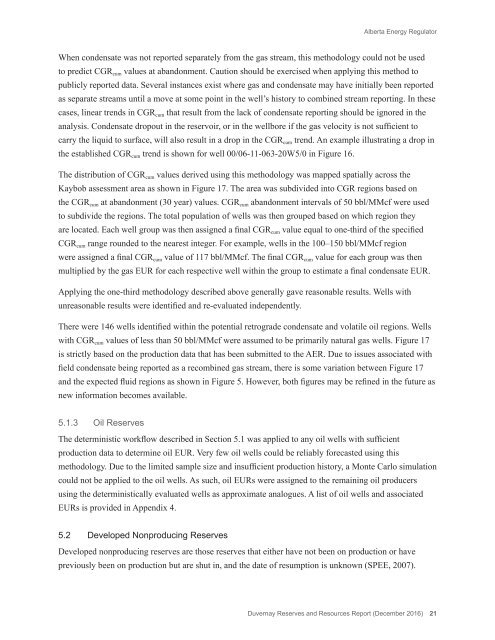Duvernay Reserves and Resources Report
DuvernayReserves_2016
DuvernayReserves_2016
You also want an ePaper? Increase the reach of your titles
YUMPU automatically turns print PDFs into web optimized ePapers that Google loves.
Alberta Energy Regulator<br />
When condensate was not reported separately from the gas stream, this methodology could not be used<br />
to predict CGR cum values at ab<strong>and</strong>onment. Caution should be exercised when applying this method to<br />
publicly reported data. Several instances exist where gas <strong>and</strong> condensate may have initially been reported<br />
as separate streams until a move at some point in the well’s history to combined stream reporting. In these<br />
cases, linear trends in CGR cum that result from the lack of condensate reporting should be ignored in the<br />
analysis. Condensate dropout in the reservoir, or in the wellbore if the gas velocity is not sufficient to<br />
carry the liquid to surface, will also result in a drop in the CGR cum trend. An example illustrating a drop in<br />
the established CGR cum trend is shown for well 00/06-11-063-20W5/0 in Figure 16.<br />
The distribution of CGR cum values derived using this methodology was mapped spatially across the<br />
Kaybob assessment area as shown in Figure 17. The area was subdivided into CGR regions based on<br />
the CGR cum at ab<strong>and</strong>onment (30 year) values. CGR cum ab<strong>and</strong>onment intervals of 50 bbl/MMcf were used<br />
to subdivide the regions. The total population of wells was then grouped based on which region they<br />
are located. Each well group was then assigned a final CGR cum value equal to one-third of the specified<br />
CGR cum range rounded to the nearest integer. For example, wells in the 100–150 bbl/MMcf region<br />
were assigned a final CGR cum value of 117 bbl/MMcf. The final CGR cum value for each group was then<br />
multiplied by the gas EUR for each respective well within the group to estimate a final condensate EUR.<br />
Applying the one-third methodology described above generally gave reasonable results. Wells with<br />
unreasonable results were identified <strong>and</strong> re-evaluated independently.<br />
There were 146 wells identified within the potential retrograde condensate <strong>and</strong> volatile oil regions. Wells<br />
with CGR cum values of less than 50 bbl/MMcf were assumed to be primarily natural gas wells. Figure 17<br />
is strictly based on the production data that has been submitted to the AER. Due to issues associated with<br />
field condensate being reported as a recombined gas stream, there is some variation between Figure 17<br />
<strong>and</strong> the expected fluid regions as shown in Figure 5. However, both figures may be refined in the future as<br />
new information becomes available.<br />
5.1.3 Oil <strong>Reserves</strong><br />
The deterministic workflow described in Section 5.1 was applied to any oil wells with sufficient<br />
production data to determine oil EUR. Very few oil wells could be reliably forecasted using this<br />
methodology. Due to the limited sample size <strong>and</strong> insufficient production history, a Monte Carlo simulation<br />
could not be applied to the oil wells. As such, oil EURs were assigned to the remaining oil producers<br />
using the deterministically evaluated wells as approximate analogues. A list of oil wells <strong>and</strong> associated<br />
EURs is provided in Appendix 4.<br />
5.2 Developed Nonproducing <strong>Reserves</strong><br />
Developed nonproducing reserves are those reserves that either have not been on production or have<br />
previously been on production but are shut in, <strong>and</strong> the date of resumption is unknown (SPEE, 2007).<br />
<strong>Duvernay</strong> <strong>Reserves</strong> <strong>and</strong> <strong>Resources</strong> <strong>Report</strong> (December 2016) 21


